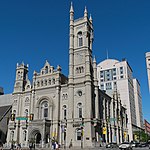Pennsylvania Academy of the Fine Arts
1805 establishments in PennsylvaniaArt museums and galleries in PhiladelphiaArt museums established in 1805Art schools in PennsylvaniaCenter City, Philadelphia ... and 11 more
Educational institutions established in 1805Frank Furness buildingsMuseums of American artNational Historic Landmarks in PennsylvaniaNational Register of Historic Places in PhiladelphiaPennsylvania Academy of the Fine ArtsPennsylvania state historical marker significationsPrivate universities and colleges in PennsylvaniaSchool buildings completed in 1876Universities and colleges in PhiladelphiaUniversity museums in Pennsylvania

The Pennsylvania Academy of the Fine Arts (PAFA) is a museum and private art school in Philadelphia, Pennsylvania. It was founded in 1805 and is the first and oldest art museum and art school in the United States. The academy's museum is internationally known for its collections of 19th- and 20th-century American paintings, sculptures, and works on paper. Its archives house important materials for the study of American art history, museums, and art training. It offers a Bachelor of Fine Arts, Master of Fine Arts, certificate programs, and continuing education.
Excerpt from the Wikipedia article Pennsylvania Academy of the Fine Arts (License: CC BY-SA 3.0, Authors, Images).Pennsylvania Academy of the Fine Arts
Arch Street, Philadelphia Center City
Geographical coordinates (GPS) Address Nearby Places Show on map
Geographical coordinates (GPS)
| Latitude | Longitude |
|---|---|
| N 39.955 ° | E -75.163888888889 ° |
Address
Le Meridien Philadelphia
Arch Street 1421
19102 Philadelphia, Center City
Pennsylvania, United States
Open on Google Maps





